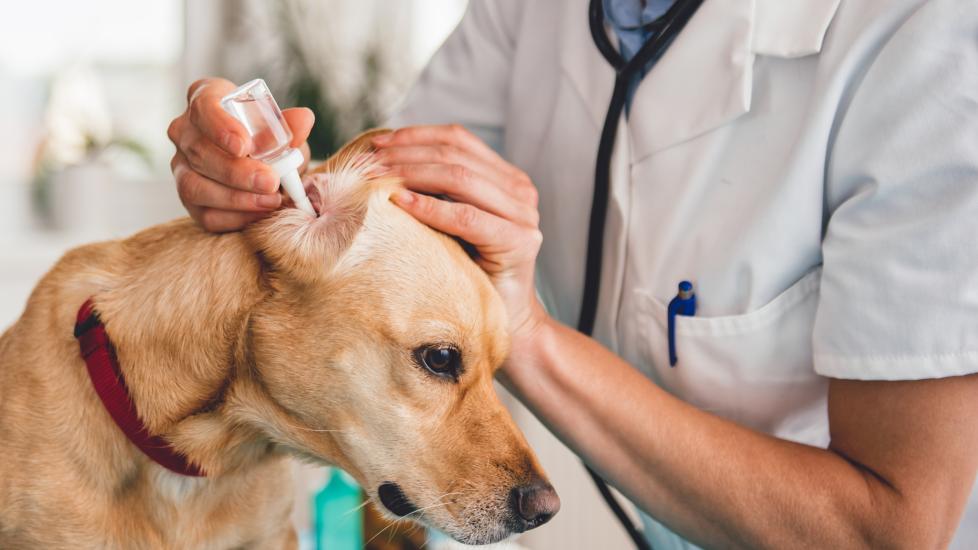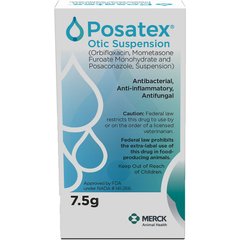Posatex® for Dogs
Kerkez/iStock / Getty Images Plus via Getty Images
PetMD’s medications content was written and reviewed by veterinary professionals to answer your most common questions about how medications function, their side effects, and what species they are prescribed for. This content shouldn’t take the place of advice by your vet.
What Is Posatex® for Dogs?
Posatex® is a veterinary prescription ear ointment FDA-approved for use in dogs for the treatment of severe, chronic otitis externa (outer ear infections) associated with yeast infections and bacterial infections.
Posatex® is an ear treatment given once daily for seven days. It is a combination product containing an antibiotic (orbifloxacin), an antifungal (posaconazole), and a steroid anti-inflammatory (mometasone).
The use of Posatex® is typically reserved for when other treatments have failed to resolve your dog’s ear infection. Posatex® is also typically reserved for when your dog has a particularly severe ear infection in which your vet highly suspects or has identified a certain strain of bacteria that is difficult to eradicate because of its resistance to many antibiotics.
Your veterinarian will perform a thorough exam of your dog’s ear and may perform microscopic tests of the ear discharge to determine if Posatex® is the best choice for your dog’s ear infection. Bacteria specimens for testing are often collected prior to the initiation of Posatex®.
Posatex® Considerations
It’s important to have your dog’s ears examined by your veterinarian first before applying Posatex®. Using Posatex® in a dog with a damaged eardrum can cause toxicity to the ear.
Posatex® should not be used in dogs with known hypersensitivity to orbifloxacin, posaconazole, mometasone, or similar medications in the same drug classes.
Posatex® should not be used in breeding, pregnant, or nursing dogs, as safety studies in these dogs have not yet been performed at the time of this publication.
Posatex® should be used with caution in dogs with recurring ear infections, liver disease, or kidney disease.
Giving Posatex® to dogs with certain medications can result in health risks to your dog, so always discuss your dog’s medications, including vitamins and supplements, and medical conditions with your veterinarian.
Posatex® is to be used short term in dogs and not for prolonged periods of time, as long-term use of topical ear medications containing corticosteroids has been associated with overactive adrenal glands.
How Posatex® Works in Dogs
Posatex® has three active ingredients: orbifloxacin, posaconazole, and mometasone.
As an antibiotic, orbifloxacin works by blocking bacteria from replicating its DNA, which prevents the bacteria from multiplying. Posaconazole works by blocking the ability of the fungi to maintain their cell membrane. Mometasone is a corticosteroid that reduces pain, swelling, inflammation, and itching.
Posatex® Directions for Dogs
Follow the directions on the drug label or as provided by your veterinarian.
Before applying Posatex® to your dog’s ear, check with your veterinarian first to ensure your dog’s ear drum is not ruptured.
Wear gloves while applying Posatex®, and always wash your hands after use.
Your veterinarian will instruct you how many drops to instill in the affected ear based on your dog’s weight.
Your veterinarian may instruct you not to clean the ear or put anything else in the ear for a certain period of time following your dog’s last dose.
Do not allow Posatex® to get into your pet’s eyes, mouth, or nose.
It is important to prevent your dog from scratching at their ears, as this can delay healing and may cause further trauma and infection. Your vet may recommend a recovery cone collar for your dog to protect the delicate tissues of their ears and face, and also to prevent other pets from licking the medication.
Contact your veterinarian if your dog’s ear infection does not seem to be healing, worsens, or if the ear infection recurs after you have completed the treatment.
Missed a Dose?
Speak with your veterinarian about what to do if you forget to give a dose of Posatex®. They may instruct you to give it when you remember, or if it is almost time for your pet’s next dose, to skip the missed dose and resume your normal dosing schedule. Do not give extra or double doses.
Possible Side Effects of Posatex® in Dogs
Posatex® is generally well tolerated in dogs. Side effects that are usually not serious include redness or discomfort in the ears. Contact your vet if the redness and/or discomfort are severe or getting worse.
Instilling ear medication when your dog’s eardrum is ruptured can cause serious side effects associated with inner ear issues including:
- Gastrointestinal signs—loss of appetite, vomiting, or diarrhea
- Sudden hearing loss
- Ear pain
- Head tilt, walking in circles
Contact your veterinarian right away if your dog is experiencing any of these symptoms.
Do not use Posatex® for longer than your veterinarian has prescribed for your dog, as long-term use of topical ear medications containing corticosteroids has been associated with overactive adrenal glands.
Human Side Effects
Posatex® is a veterinary medication not intended for use in humans.
If you have hypersensitivity to cortisone, fluoroquinolone antibiotics, or antifungal medication, talk to your veterinarian about using another medication, or ensure that you always wear gloves while handling this medication.
Wash your hands after application. In case of accidental skin contact, wash the area thoroughly with water. Avoid contact with eyes.
Due to possible side effects, humans should never use medicine dispensed for their pets and pets should not be given any medicine dispensed for a human’s use.
If you accidentally ingest a veterinary medication, call your physician or the national Poison Control Center hotline at 800-222-1222.
Call Your Vet If:
- Severe side effects are seen (see above)
- Your pet’s condition worsens or does not improve with treatment
- You see or suspect an overdose
- You have additional questions or concerns about the use of Posatex®
Posatex® Overdose Information for Dogs
An overdose of Posatex® is unlikely to occur unless your pet ingests the topical medication.
Overdosage by mouth may suppress your pet’s immune system.
Prolonged use (longer than the maximum recommended treatment duration of seven days) or administration of higher dosages than your veterinarian prescribes may cause redness, pain, swelling, and heat of the affected ear, and suppression of your pet’s immune system.
If you suspect an overdose, immediately contact your veterinarian, seek emergency veterinary care, or call an animal poison control center. Consultation fees often apply.
Pet Poison Helpline (855) 764-7661
ASPCA Animal Poison Control (888) 426-4435
Posatex® Storage for Dogs
Always confirm storage requirements by reading the prescription label.
Posatex® should be stored in its original container at temperatures between 35.6-86 F.
Keep out of reach of children and pets.
FAQs
What is Posatex® used for in dogs?
Posatex® is a veterinary prescription ear medication used in dogs for the treatment of severe, chronic outer ear infections associated with susceptible yeast infections and bacterial infections.
Is Posatex® prescription only?
Yes. Posatex® is only available by prescription through your veterinarian.
What are the side effects of Posatex® ear drops?
Posatex® is generally well tolerated, but side effects such as redness or discomfort at the site of application may occur. If your dog’s eardrum is ruptured, Posatex® can cause inner ear issues including sudden hearing loss, loss of appetite, vomiting, diarrhea, ear pain, head tilt, and walking in circles.
No vet writer or qualified reviewer has received any compensation from the manufacturer of the medication as part of creating this article. All content contained in this article is sourced from public sources or the manufacturer.



